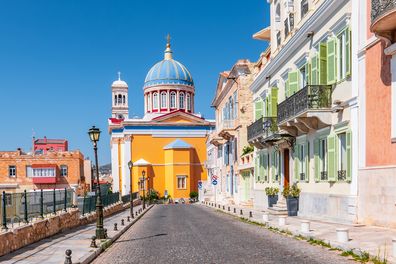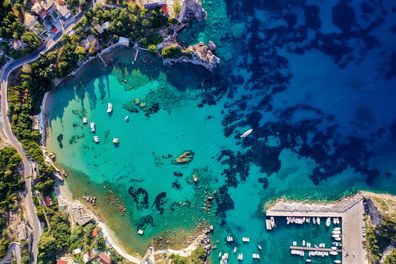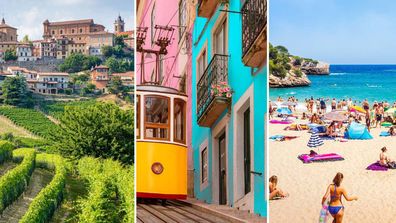Travel
Major ‘mistake’ to avoid when visiting the Greek Islands

Azure waters, white-washed villages with vibrant pops of bougainvillaea and hot, salty nights featuring tables laden with bottles of ouzo and – let’s face it – a tremendous amount of carbs; a Greek Islands holiday is as wonderful as it sounds on paper.
Yest, with some 6,000 islands on offer (don’t worry, only 200 or so of these are inhabited), it can be overwhelming when it comes to the actual planning of said trip.
The good news? We’ve got a few tips to help you get started on making your Greek Islands dream a reality.
READ MORE: The key things to know about visiting Paris on the cheap
1. Visiting in peak summer
Okay, there’s no denying you – like every other person on the planet – would prefer to visit the Greek Islands when the sun is blazing and the days are super-hot, but late June, July and August are best avoided.
Not only do the islands become overcrowded, local prices are at their highest and temperatures are hovering around (and many times above the 40 degree mark.
Aim for early June, or better yet, any time in September or October.when the temperature is still in the low- to mid-20s but the summer crowds have died off and prices are rock bottom. You’ll get far more bang for your buck.
READ MORE: Most beautiful places along the Western Australia coastline
2. Making it all about Santorini and Mykonos
Blame Instagram, but Santorini and Mykonos remain two of the most popular islands. How you should be reading that sentence is ‘Santorini and Mykoos are above and beyond the two most eye-wateringly expensive islands’.
If you want true Greek Island charm for a fraction of the cost of what you’d pay for accommodation and meals, consider Tinos, Folegandros, Naxos, Lefkada, Sifnos, or for those who prefer a larger island which boasts a wide range of accommodation options and activities, Crete.
READ MORE: If you’re not regularly cleaning your suitcase between trips, you might want to reconsider

3. Not checking cruising schedules
One of the biggest challenges of visiting the more popular Greek Islands is the overabundance of cruise tourism, with up to five mega-ships – or more – visiting some islands at the same time. Whether you’re cruising yourself, or just plan to leave your accommodation to get out and about, it’s a good idea to check the cruise schedule to see just how many cruises are in port.
On days (in Santorini, for example) where there are several ships in, the wait for cable cars to take you up to town can be hours long and the wait to get a table at some of the island’s best restaurants, next to impossible.

4. Not doing your homework on beach clubs
Thinking about hitting the beach? It’s rarely a simple case of just throwing a towel on the sand. Although it’s possible, beaches are dominated by beach clubs so that sun loungers with umbrellas take up the lion’s share of the sand, leaving a tiny patch for those who’d rather not pay skyhigh rates for beach real estate.
If you decide to go to a beach club, always ask about their pricing model (some will give you a price to get you in the door, but then tell you that’s the rate for those who also eat in-house, or they’ll say the sunbed is ‘free’ with the purchase of one drink which you later discover is a €48 orange juice).
Ask lots of questions and be clear about inclusions before you take a seat. Also try to pay cash where possible, as some shady operators have been known to skim cards or tap twice.
5. Ignoring the local buses
Taxi drivers, where do you even begin? While convenient, their rates can really hit the back pocket. Although the bus depots around the larger islands are chaotic, local buses – yes, even those on Santorini and Mykonos – are not only cheap, they’re luxurious air-conditioned coaches delivering you to other towns or to the beach half an hour away for around €2.
6. Booking last minute
As with anywhere else, the sooner you book your holiday, the lower the airfare and better the rates for accommodation. While you’re booking, remember, too, to pre-book inter-island transport, attractions and make reservations for popular restaurants. This is essential if you’re travelling within the summer months.

7. Trying to see too many islands
Some islands are located right next to each other, making quick ferry transfers surprisingly easy. Others are located just off the coast of Athens, or off the coast of Turkey.
When there are so many islands at your disposal, it can be easy to try to shoehorn as many islands into your itinerary as possible, to fully immerse yourself in Greek life and culture (plus give yourself a chance to actually relax), aim to spend at least three days on each island. That should give you some idea of how many islands to include on your itinerary, whether you’re staying for one week or two.
8. Not planning out your port visit
If you’re cruising through the Greek Islands, your biggest challenge will be beating the crowds to the top spots. Your best bet is to get off the ship the minute disembarkation is allowed and make a beeline to the number one thing you wanted to see or do on that particular island (if you want to get that key blue dome shot in Santorini, for example).
Stick to the main drag until it becomes overcrowded and then head to the beach or the lesser explored parts of the island until later in the day when the majority of passengers would already be back on the ships.

9. Overlooking Athens
Using the capital as a quick ‘see the Acropolis and bolt’ stopover? We’re going to stop you right there; Athens is a vibrant destination worthy of a solid, multiple-day stay. Book a hotel (or Airbnb) in and around Plaka sure and definitely see all the big-ticket historic sites, attractions and museums, but don’t miss checking out the beaches of Athenian Riviera – or beyond – as well.
Remember that the Greek Islands, while lovely, only make up 20 percent of the country; there’s so much more to explore on the mainland.











